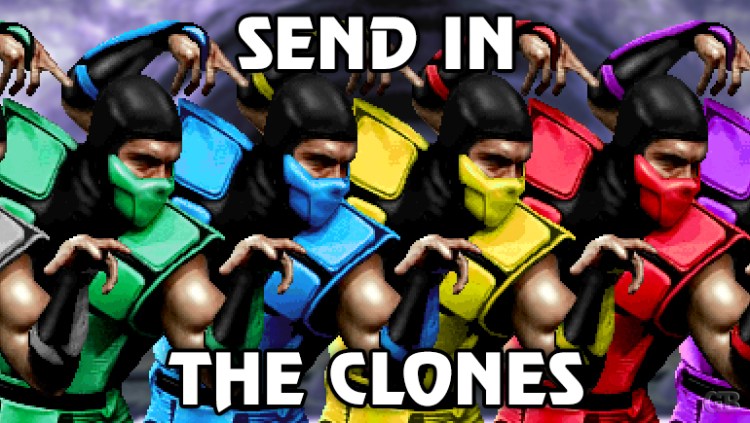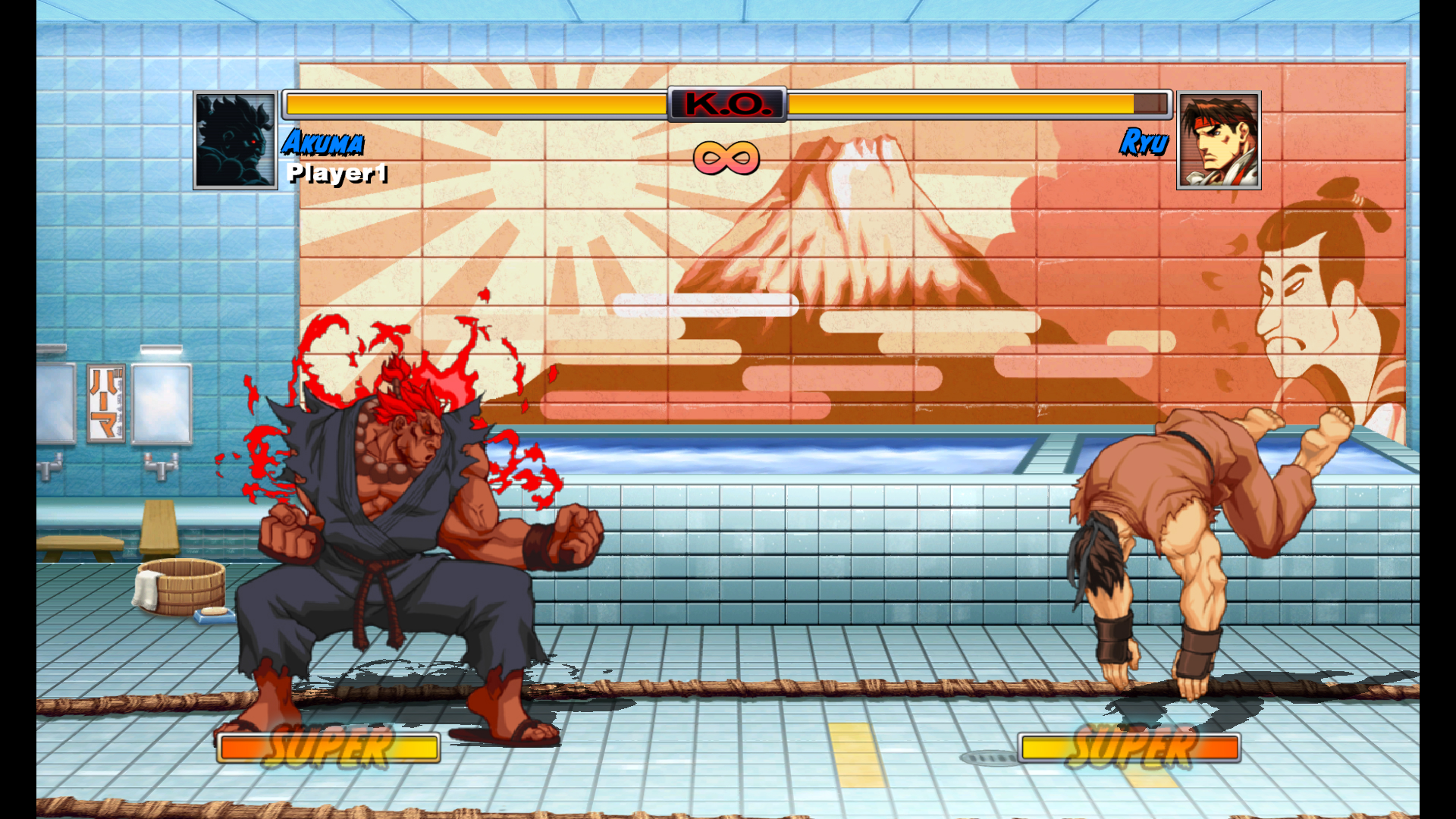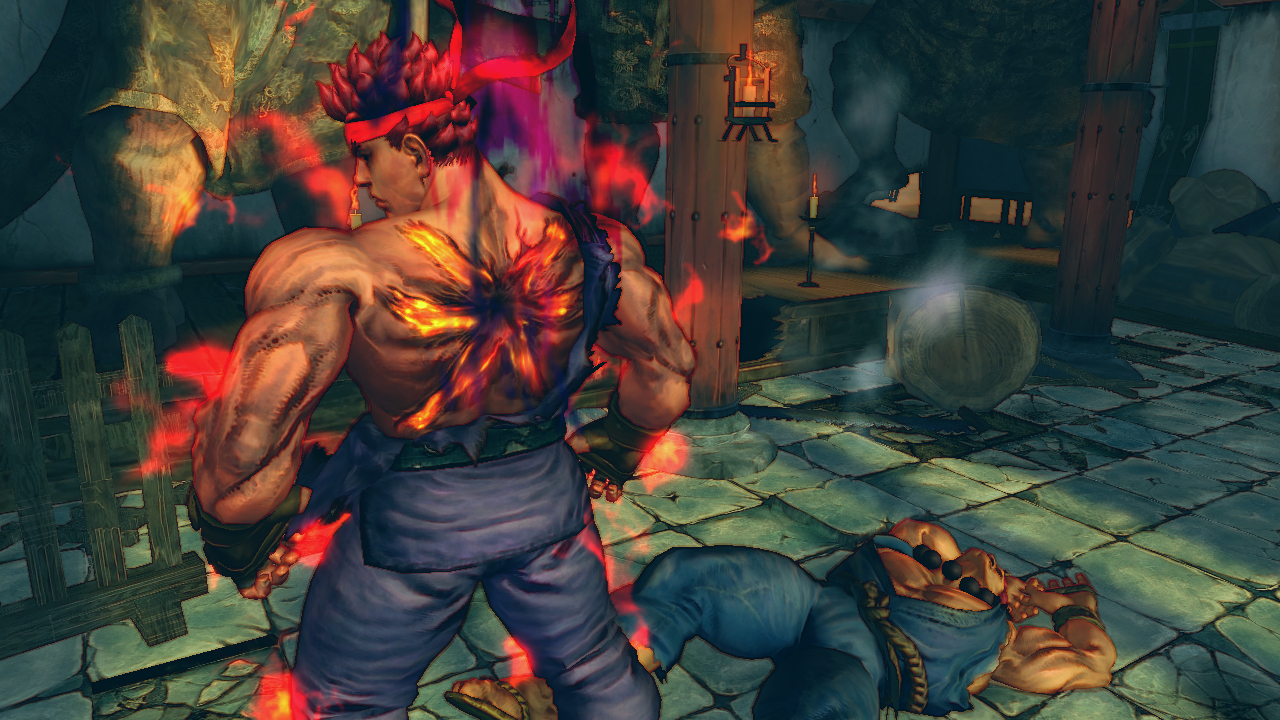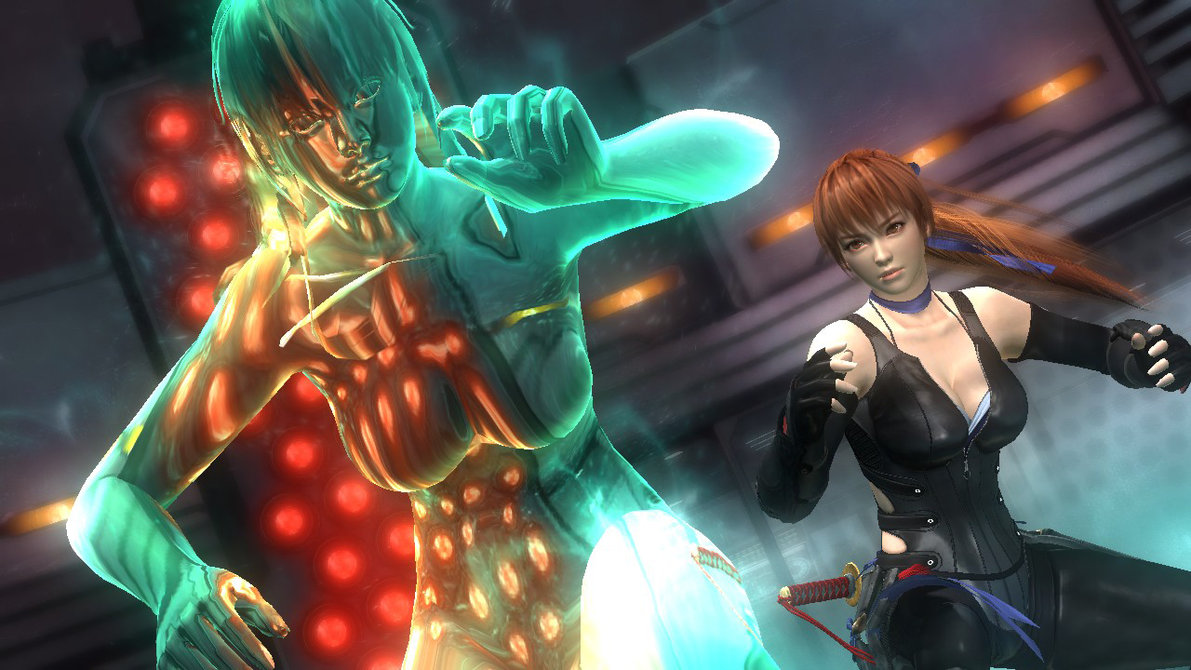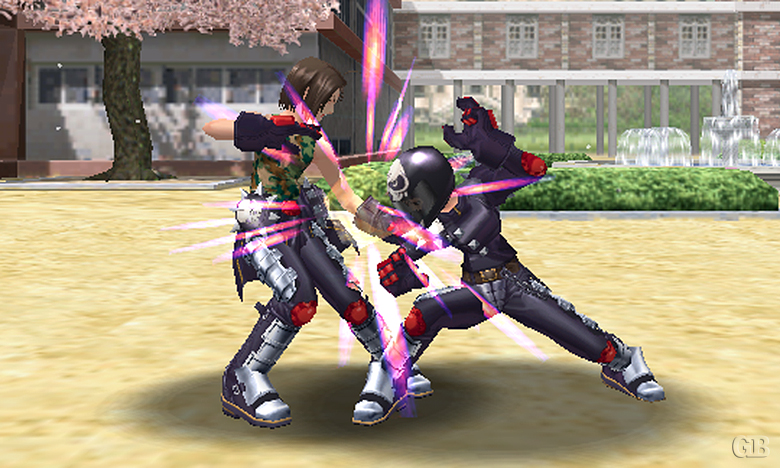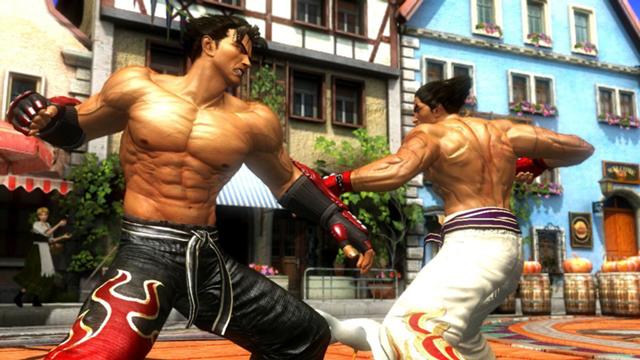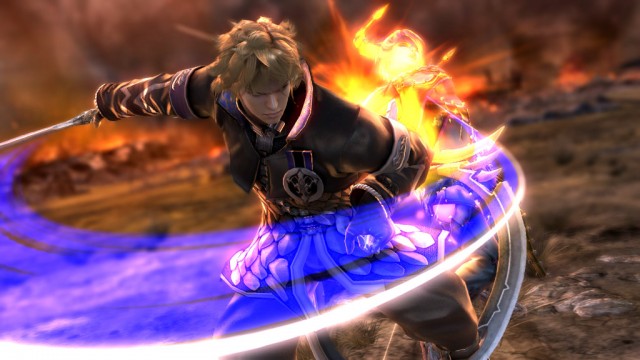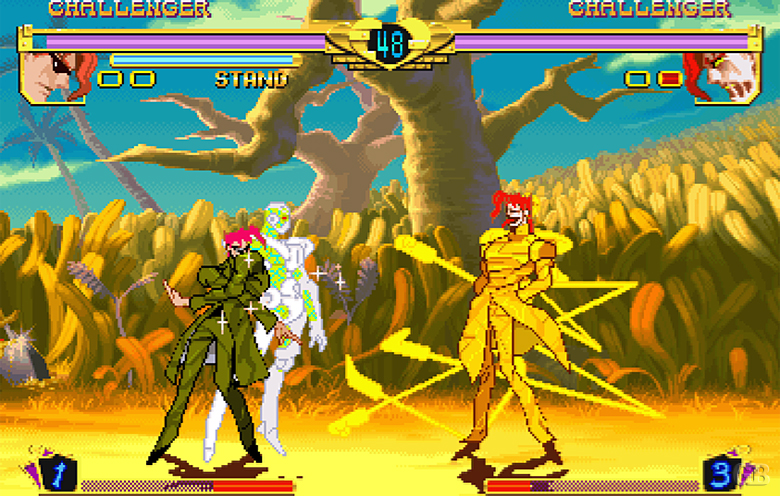Evil Ryu. Cyber Sub-Zero. Devil Jin. Orochi Iori. Shadow Labrys. Never count out a fighting game developer’s ability to recycle existing assets to assemble a new warrior. In the past year alone, Capcom released Decapre, a blatant Cammy clone, for Ultra Street Fighter IV. Meanwhile, Persona 4 Ultimax will bring in two versions of the same villain: Sho Minazuki.
Some additions are as dull as you would expect, but others rise above their lot to create their own fanbase. Let’s journey through the halls of history to pay homage to the best and worst of these pseudo-newcomers.
The Street Fighter Karate Guys
Hall of Fame: Akuma (Super Street Fighter II Turbo)
Model: Ryu
Of course, Capcom is no stranger to reusing models. Ryu has had Ken as a rival since the first Street Fighter, and over time he would meet more “shotos” who had an affinity for karate gis, fireballs, and uppercuts. Akuma was the first to show up, and from his first appearance in Super Street Fighter II Turbo as a secret boss, this master demonstrated unprecedented techniques such as air projectiles and his Raging Demon super grab. His status as a “glass cannon” in versus play also opened up a new playstyle for those who want a ton of great moves at the cost of terrible health. Meanwhile, Akuma’s rivalry with Ryu gave the original a new dynamic as he had to prove to his master’s would-be murderer that the path of a true warrior is not soaked in blood.
Hall of Lame: Evil Ryu (Street Fighter Alpha 2)
Model: Ryu
Isn’t Akuma already a dark version of Ryu? So why do we need an Evil Ryu with a few of Akuma’s moves? To be fair, Evil Ryu did become more interesting in the Street Fighter IV series after gaining some new skills that turned him into a big-damage machine. Even then, however, the “Evil” moniker helped turn the rivalry between Ryu and Akuma from a philosophical conflict to whether turning yourself into a demonic Super Saiyan is a good idea.
Masked Warriors
Hall of Fame: Reptile (Mortal Kombat)
Model: Scorpion and Sub-Zero
It’s even easier to add to the roster when one of your warriors covers his face, especially in games that used “digitized” sprites taken from real-life models. Originally a hidden opponent that you had to meet convoluted conditions to face, Reptile represented two Mortal Kombat traditions: Hidden secrets and making new warriors just by swapping the colors of its masked ninjas. After all, Scorpion and Sub-Zero symbolized the franchise, and the trick helped the team save precious memory. As time went on Reptile would turn more lizard-like with scaled skin and acidic attacks, and MK’s numerous ninjas would remain popular whether man, woman, or cyborg.
Hall of Lame: Blade, Arkane, Khyber, and F7 (Street Fighter: The Movie)
Model: Each other
So who else is in M. Bison’s criminal organization besides a boxer, a matador ninja, and 12 brainwashed assassins? Apparently these stormtroopers from the camp classic movie who made their only videogame appearance in the only Street Fighter title that uses digitized graphics. Each mook had his own color (red, blue, yellow, and black) and different special moves, but F7 negated the point of that by having the arsenals of all the others combined. Not only did these living props never make it to a major Street Fighter game, but they also never even made it to the console version of the same game.
Next: Blood rivalries born from family ties or forbidden experiments
Siblings
Hall of Fame: Urien (Street Fighter III: 2nd Impact)
Model: Gill
Brothers and sisters will always rough-house when they’re little, but what happens when they become champion martial artists? Rather than tone down Street Fighter III boss Gill to make him a playable character, Capcom introduced Urien as a violent usurper who wants to be the Sword of Damocles hanging over his brother’s throne. The arrangement works out well: Gill maintains his aura as an unstoppable demigod while Urien has developed his own unique moves like the Chariot Tackle and Aegis Reflector to become a hardcore favorite.
Hall of Lame: The Jin Twins (Fatal Fury 3: Road to the Final Victory)
It’s tough to make twins work: They’re either both cool or both expendable. Jin Chonrei (blue) and Jin Chonsue (red) started as powerful bosses under the possession of ancient Chinese warriors. Their search for the powerful “Jin scrolls” continued in later sequels, but aside from an appearance in Neo Geo Battle Coliseum they would fade into SNK history. Despite their impressive pedigree, these brothers didn’t intimidate anyone with their stumpy bodies, boring techniques, and wardrobe that looks more like Halloween costumes than imperial regalia.
Evil Doppelgängers
Hall of Fame: Robo-Ky
Model: Ky Kiske
Perhaps your evil twin is a product of science. Robo-Ky first appeared in the story mode of Guilty Gear X2 as a meddlesome imposter of Ky Kiske. Like most clones, he played very similarly to his inspiration, but that changed quickly when developer Arc System Works re-engineered him into a metal madman who attacked with hammers, missiles, eye lasers, and flying unicycles. With his own unique super meter and “overheat” gauge, this robot went from a rehash to one of the most complex fighters ever created.
Hall of Shame: Kasumi Alpha/Alpha-152 (Dead or Alive 2)
Model: Kasumi
It’s clear that developers prefer basing their clones on a franchise’s most popular characters. They already have a connection with fans, so a remixed version will have a built-in audience. I’m guessing that’s what Temco thought when it copied Dead or Alive’s Kasumi so many times. Kasumi Alpha appeared in Dead or Alive 2 as an off-kilter replica of the kunoichi. She would later transform into the hypercheap boss Alpha-152 for Dead or Alive 4. While she does gain a unique fighting style, her bland translucent form makes for an anti-climatic nemesis. If you need even more Kasumi in your life, you can download a new doppelgänger, Phase 4, in Dead or Alive 5 Ultimate.
Next: Suit up for action! If that fails, have your children avenge you.
Battlizers
Powered Akira (Rival Schools)
Model: Akira
Evil characters are rampant in the genre, but you don’t always have to sacrifice your virtues to improve yourself. In order to convince the delinquent students of Gedo High to help her find her brainwashed brother, Akira pulls a Samus Aran and disguises herself as a masked biker. It’s only after the game is over that we see the modest tomboy underneath. While Powered Akira is the default form in the original, in the sequel she starts out unmasked, and you can unlock her helmeted form through the story mode. The two both have a hard-hitting close-range combat style, but Powered Akira’s strikes have the extra gusto that sends her fellow classmates flying.
Hall of Lame: Armored Ralf (The King of Fighters 2006)
Model: Ralf Jones
This mercenary is always ready for a fight in The King of Fighters series, but him and his teammate/fellow headswap Clark seem underpowered compared to the martial arts legends, psychics, and demon hosts they run into. Maybe that’s why SNK gave Ralf this spike-fisted suit for its short-lived Maximum Impact line of 3D brawlers. Too bad it wasn’t worth it: Not only does Armored Ralf look like a dollar-store GI Joe, but he’s also overpowered since he is unthrowable and shrugs off many attacks.
‘Passing the Torch’
Hall of Fame: Jin Kazama (Tekken 3)
Model: Kazuya Mishima
Tekken understood from the beginning how easy it is to re-use 3D models and animations to create “new” warriors like Armor King and Prototype Jack. No one thought back then, however, that one of them would become the face of the franchise. After the “death” of series star Kazuya in Tekken 2, the timeline jumped several years to when his son, Jin, could replace him. With his cooler design, Jin led a youth movement that made Tekken 3 the most successful fighter on the PlayStation 1. While Jin originally used the Mishima-style karate of his father’s family, after Kazuya made his comeback, Namco overhauled the son’s fighting style and explained it in-game as Jin wanting to remove any ties to his lineage. That doesn’t keep him from returning to it, however, after he gets his own clone in Devil Jin.
Hall of Lame: Alpha Patroklos
Model: Setsuka
For Soul Calibur V, Namco emulated the success of Tekken 3 with a timeskip that saw new warriors take up familiar blades. Patroklos inherits the sword and shield of his mother, Sophitia, but as part of the plot he eventually abandons them in favor of the powerful Soul Calibur. He also switches his combat style to that of Setsuka, an European geisha from earlier entries who used a blade hidden inside an umbrella. She was the one who taught Patroklos swordsmanship, but it seems wrong to replace someone who is visually dynamic for a guy who never stops being a tool. It’s not like Setsuka would be too old to compete — if anything, it would make her even more interesting!
Next: Any excuse for a new character…
Anime
Hall of Fame: Young Joseph Joestar (JoJo’s Bizarre Adventure)
Model: Joseph Joestar
Anime and manga such as the generations-spanning JoJo’s Bizarre Adventure have a smorgasbord of different forms for the same hero. Joseph Joestar is both the protagonist of the manga series’ second arc as a cocky teenager and a key ally in the third arc as a grouchy grandfather. He also fights very differently in those storylines as the young JoJo perplexes his enemies with strange tactics while as an old man he relies on the thorn-like “stand” Hermit Purple. In the 1998 arcade title a simple headswap allows fans to pick the Joseph they prefer, and the two have reappeared again in the recent JoJo’s Bizarre Adventure: All-Star Battle for PlayStation 3.
Hall of Lame: Rubber Soul and New Kakyoin (JoJo’s Bizarre Adventure)
Model: Kakyoin
The ’90s arcade title did go a little overboard with palette swaps: Five characters have alternate versions, and the traveling student Kakyoin has two by himself. Rubber Soul is a villain who masquerades as Kakyoin in an attempt to pick off his allies one by one. He isn’t so bad since the raunchy killer does have unique moves like his signature backbreaker. New Kakyoin is mostly similar to the original except with a pair of shades on, which are as iconic to the character as his love of cherries. Good grief.
‘We’re that Lazy’
Hall of Fame: Fukua (Skullgirls Encore)
Model: Filia
After years of financial drama and an $830,000 crowdfunding campaign, Skullgirls is now free to design innovative warriors like Squiggly and Big Band. Meanwhile, Capcom spent half a year hyping fans about a mystery character for Ultra Street Fighter IV, the most popular competitive fighting game in the world, only to reveal a Cammy clone. On April Fool’s Day, Skullgirls develop Lab Zero Games called Capcom out on its antics with the reveal of Fukua, a palate swap of heroine Filia it made in a few days. Not only did Lab Zero create a fully functioning character for the prank, but she eventually became an official part of the roster.
Hall of Shame: Bone Claw Wolverine (Marvel vs. Capcom 2: New Age of Heroes)
Model: Wolverine
The early Marvel vs. Capcom games had a variety of color-swapped heroes such as Shadow Lady and Gold War Machine. But none were as lazy as when Capcom padded out the roster of Marvel vs. Capcom 2 with two versions of Wolverine. At first, you can only select Bone Claw Wolverine, but eventually you’ll unlock traditional Metal Claw Wolverine, who does less damage but has more techniques. Ultimately, their only purpose was to fulfill a marketing bullet point.
A special thanks to Samir Torres for his assistance.
VentureBeat's mission is to be a digital town square for technical decision-makers to gain knowledge about transformative enterprise technology and transact. Learn More
